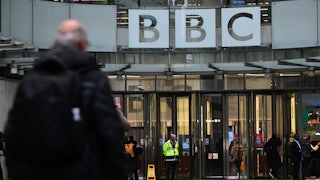The government shutdown is over, for now. But the administration’s fight against food assistance might just be beginning. Ever since the Trump administration stopped sending Supplemental Nutrition Assistance Program, or SNAP, payments during the U.S. government shutdown, regular people, not just policy nerds, have been talking about SNAP and government food assistance. There are TikTok videos and explainers; there are a thousand heartrending stories about the way food assistance touches our lives. Politicians are talking about how they’re standing up for food stamps. People are pitching in—donating to and volunteering at food banks, offering free meals at their coffee shops and restaurants. “I used to wish we could talk about SNAP as much as we hear about Medicaid,” Ty Jones Cox, vice president of food assistance at the Center on Budget and Policy Priorities, told me. “Now everyone is talking about SNAP. Everybody is paying attention.”
Donald Trump has noticed. Before this, Trump reserved much of his ire for Medicaid and the Affordable Care Act, when it came to the social safety net. He rarely talked about SNAP or other food assistance programs, like WIC—the Special Supplemental Nutrition Program for Women, Infants, and Children.
Trump now appears to see SNAP as a political threat. “We can reform SNAP, and I think we should,” Trump said on Monday night in a Fox News interview, even as some Democrats readied a deal with Republicans to end the shutdown. “It really puts the country in jeopardy,” he added, claiming that people leave their jobs because “it’s easier” to be poor and rely on income-limited programs like these.
The shutdown ended on Thursday after a record 43 days. But SNAP recipients were still awaiting their payments—and Brooke Rollins, the secretary of the Agriculture Department, which administers the program, dismissed these concerns in a CNN interview on Thursday. “SNAP is a broken program. SNAP is full of corruption,” Rollins said, claiming the administration had found the names of 186,000 dead people on SNAP lists in 29 states—but she offered no evidence that the dead people were receiving benefits.
This continued focus on food stamps, even after the end of the shutdown, raises red flags. “It’s something that I worry about,” said Benjamin Chrisinger, an assistant professor at Tufts University and a visiting research scholar at Princeton University’s Center for Health and Wellbeing. “Is this setting up a bigger undermining of the program?” That would have enormous repercussions throughout the country, Chrisinger said. “To fully call the program into question is quite concerning because it is our main food insecurity program. That is all we’ve got.”
During previous shutdowns, including the 2019 shutdown under the first Trump administration, SNAP continued operating as normal. The fact that the second administration refused to tap into the emergency fund this time—and brought the issue all the way up to the Supreme Court—is itself worrying to those who follow food assistance.
“SNAP has not faced this extent or level of threat before,” said Jamila Michener, a government and public policy professor at Cornell University. It’s not like a program for low-income people is ever sitting safe and pretty in the United States, she said. But in such an unpredictable administration, “there could potentially be new threats” to food assistance and other vital programs.
With so much attention, SNAP watchers are hopeful that the public will understand food stamps better than before and fight against cutting or significantly altering the program. But “it’s in the spotlight, and I don’t know that that bodes well,” Chrisinger said.
Until the shutdown, SNAP hummed along rather efficiently, an incredibly complex machine fine-tuned over the decades. This interruption created new fractures and fault lines, and the differences in how states responded to the SNAP halts were “staggering,” Chrisinger said. “The chaos of this, politically and legally, is showing some of the cracks.”
That’s not to say food assistance was totally safe before all of this. SNAP, like all safety net programs, has endured conservative attacks throughout the years—culminating, in July, with the biggest cuts to SNAP in its history. Trump’s megabill introduced new work requirements and cut $187 billion from SNAP in order to fund tax cuts for wealthy individuals and corporations.
The cuts will happen in phases, with new requirements taking place at different times in different states—making it difficult to point directly to disruption, said Jones Cox. “It could get hidden behind other things that are happening.”
Some states, most of them red, are also beginning a program in January to limit which foods may be purchased through SNAP. Six states, including Florida and Idaho, will start restricting SNAP in January, and six more states will implement other restrictions over the course of 2026—prohibiting soda or sugar-sweetened beverages, or cutting candy and “unhealthy foods,” a priority for the Trump-aligned “Make America Healthy Again” movement. (There are already limits on buying warm food, which some states overcome with a waiver.)
There are also actions that states opposed to SNAP can take to make it harder to apply for and stay in food assistance programs. “States can make it more of a pain to stay in SNAP with recertification and documents and form filling,” Chrisinger said.
“Maybe they don’t have their online application open as long or they don’t have the times that you can come in the office,” Jones Cox said.
And, as Trump has done with USAID and other public health funding, he could simply cut programs unilaterally or indefinitely delay payments.
Even if SNAP survives Trump’s scrutiny for now and the program continues, it’s not great if he keeps harping on it. Framing the program as wasteful, inefficient, and fraudulent could sway public opinion about SNAP, Jones Cox said. Trump could use his bully pulpit to continue spreading misinformation about who receives SNAP and what they use it for, and that could influence legislation and the way states administer the program, Michener said.
“In this moment, it feels like nearly anything is possible when you are dealing with an administration that is in many ways expert at identifying where the cracks in our systems and our rules and our norms are, and leveraging those to the greatest extent possible to cause pain in the ways that [they] want to cause pain,” Michener said.
For a long time, food stamps have enjoyed bipartisan support—in large part because they merge the business interests of food producers and retailers with concerns about hunger in America. People with SNAP benefits can then spend more of their money on rent, utilities, medical bills, and other expenses.
“There should be a broader coalition of folks standing up for SNAP. We’ll see if they jump into the fray and come to its defense,” Chrisinger said. “If SNAP’s not safe, it makes me wonder and worry—what other safety net programs are not safe? Because not all safety net programs have that kind of retailer business network defense that SNAP does. So I wonder if it’s also a bit of a signal of other things to come.”
SNAP, Jones Cox agreed, “not only helps the participants who are on it, but retailers where the money is spent, farmers markets where people can spend their benefits; it helps businesses, helps them be able to hire.” Walmart and Amazon, for instance, are both major retailers with many employees who are on SNAP as well as a brisk business selling food to SNAP beneficiaries.
The groundswell of support for food stamps could outweigh the negative attention they’re getting from conservatives and the Trump administration. “This has been an opportunity to really show the positive side of our country and how we build community and help stick up for our neighbors,” Jones Cox said. “People are making noise.”
Michener is on the board of her local food bank, where they have been grappling with not only how to feed everyone in need but how to address the whole system—how to make the line of people who need food shorter. The bank started a community advocates program to equip those who need food with civic skills: Do you know how to reach out to your elected officials? Do you know how to tell your story? They’re getting involved in the political processes that determine what kinds of wages their employers have to pay them or whether they have access to benefits, Michener said. “The most surefire way to strengthen these programs is to strengthen the political power of the people who rely on the programs.”








